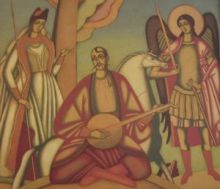This exposition launches new project “Echo” which will present the dialogue of cultures, continuity of traditions, and, what is so important in the present time, reflection on the past.
This project is the first attempt to show how one of the most striking phenomena of the Baroque culture – folk painting Cossack Mamai is interpreted in works of contemporary Ukrainian artists. The exhibition presents works of 22 artists: Feodosii Humeniuk, Halyna Sevruk, Oleksandr Ivakhnenko, Valerii Franchuk, Vasyl Lopata, Volodymyr Harbuz, Oleksandr Melnyk, Petro Hanzha, Leonid Hopanchuk, Maryna Yatsenko, Natalia Kucher, Vasyl Kopaihorenko, Mykhailo Haiovy, Yurii Lohvyn, Yurii Kucherenko, Viktor Tsapko, Volodymyr Taran, Mykhailo Onatsko, Lilia Bondarenko, Halyna Dyhas, Liubov Minenko – all in all about 40 paintings. The exhibition also features literary works by Oleksandr Ilchenko, Ihor Kalynets, Volodymyr Rutkivsky, Leonid Horlach, Raisa Lysha along with art research works of contemporary scholars – “Cossack Mamai” by Stanislav Bushak, etc.
Mysterious and enigmatic Cossack Mamai. His image is all full of legends, praised in folk songs, and for centuries it has been the measure of victory and greatest virtues of Ukrainian mentality.
Without going into historical explorations and scientific explanations, we should note that this image has really, in fact, gone deep into the subconsciousness of the Ukrainian people and keeps the genetic memory from fading away.
Every researcher has his own interpretation of the legendary Cossack: as a nostalgia for the past (Platon Biletsky), as meditation of the Ukrainian people on their nature (Olena Apanovych), as an archetype of the “warrior of the solar deity” encoded into figurative form (Oleksandr Naiden), as a symbol that preserves the historical memory of the people, strengthens the ideals of a peaceful guard of his land, a courageous, focused, and dreaming man (Stanislav Bushak).
Similarly, the artists feel and portray Cossack Mamai in different ways: as a brave ascetic (Humeniuk), sad prophet (Franchuk), cosmic solar hero (Harbuz), sophisticated singer and charmer (Sevruk), dragon slayer (Melnyk), invisible poet with birds (Minenko), gentle dreamer with angels (Taran). The voice of cultures echoes through millenniums in the works of Hopanchuk depicting special versions of Mamai – stone statues in ancient-time steppe. In the painting of Kopaihorenko these symbolic artistic phenomena are connected: Cossack Mamai is singing to the stone Mamai.
Thus, naturally, Cossack Mamai was the most important informal symbol of the Ukrainian people: in the situation when Ukraine did not have its own statehood he suggested official symbols – flag and emblem. His image was placed in rural homes along with icons. We can see Cossack Mamai in the interior of the Bohdan Khmelnytsky’s residence in the etching of Taras Shevchenko Gifts in Chyhyryn. Heorhii Narbut, who was the first among the artists to note the high aesthetic value of the image of Cossack Mamai, depicted him on the emblem of the Ukrainian People’s Republic in 1918. Carol singers from the Club of Creative Youth in the early 1960s for Christmas carried the image of Cossack Mamai together with the star. Opanas Zalyvakha and Ihor Kalynets turned to this image in Soviet prisons. During the time of combating Ukrainian nationalism (late 1960s and early 1970s) Mamai as a living symbol appeared in paintings by Alla Horska and in graphics and ceramics by Sevruk.
Today we have the pleasure to contemplate the image of Cossack Mamai in all the variety of contemporary Ukrainian art. Despite all kinds of spiritual sediment he is a harmonious part of our lives and reminds us, Ukrainian people, once again not to forget about our roots.
The exhibition is particularly interesting and important in the context of the new law on language. We hope that the exhibition will help the public realize that they are Ukrainians and the project “Echo” will go beyond the Museum space and will find many supporters.
Different Versions of Mamai is open until August 28.








